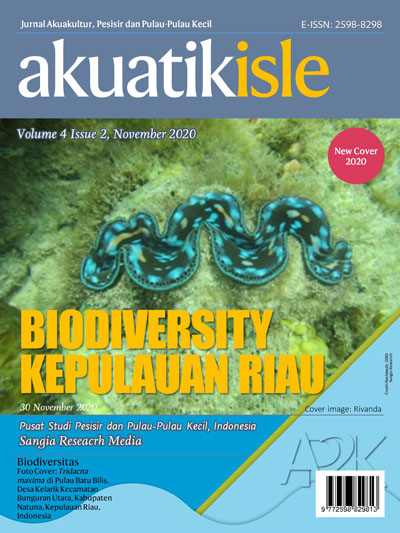Akuatikisle: Jurnal Akuakultur, Pesisir dan Pulau-Pulau Kecil
Full Length Article
Conditions and pattern of utilization of gonggong snails in Penyengat Island waters, Tanjungpinang Kota District, Riau Islands, Indonesia
Kondisi dan pola pemanfaatan siput gonggong di Perairan Pulau Penyengat Kecamatan Tanjungpinang Kota, Kepulauan Riau, Indonesia
Highlights
Generate NLP AI by Wizdam ID.
Abstract
This study aims to determine the conditions and patterns of utilization of snails in the Penyengat island waters, Riau Island, Indonesia. The method used was purposive sampling of 5 stations with 70 x 2 m quadratic transect for the density of the Gonggong Snail. The results found two types of snail bark species namely Laevistrombus turturella and Strombus urceus with a total density value of 0.114individual per m². The use of snail bark patterns in Penyengat Island waters, namely the size of the catch is medium to large, manual capture techniques (collected by hand), the catching area in the waters of the island is 100-200 m from the beach, the most catches found >100 individuals, season and time of catching snail barks at stinging island waters are not based on season, utilization and distribution of utilization. The snail bark resource is used for consumption and sold to collectors.
Abstract
Penelitian bertujuan untuk mengetahui kondisi dan pola pemanfaatan siput gonggong di perairan Pulau Penyengat, Kepulauan Riau, Indonesia. Metode sampling yang digunakan adalah purposive sampling sebanyak pada 5 stasiun dengan transek kuadrat berukuran 70 x 2 m untuk kepadatan Siput Gonggong. Hasil penelitian ditemukan dua jenis siput gonggong spesies yaitu Laevistrombus turturella dan Strombus urceus dengan nilai total kepadatan sebesar 0,114 individu per m². Pola pemanfaatan siput gonggong di Perairan Pulau Penyengat yaitu ukuran tangkap yaitu ukuran sedang hingga besar, teknik penangkapan dengan cara manual (dipungut menggunakan tangan), area penangkapan di perairan Pulau Penyengat yaitu 100-200 m dari pantai, jumlah tangkapan yang paling banyak didapati >100 individu. Waktu penangkapan siput gonggong diperairan pulau penyengat tidak berdasarkan musim, pemanfaatan, dan distribusi pemanfaatan. Sumberdaya siput gonggong dimanfaatkan untuk konsumsi dan dijual ke pengepul.
Keywords
Introduction
Section snippets
Material and Methods
Materials and methods from the full-text PDF of this article cannot be displayed.
Results
Results from the full-text PDF of this article cannot be displayed.
Discussion
Discussion from the full-text PDF of this article cannot be displayed.
Conclusions
Conclusions from the full-text PDF of this article cannot be displayed.
Acknowledgment
Acknowledgment from the full-text PDF of this article cannot be displayed.
Competing interest
The authors declare that they have no known competing financial interests or personal relationships that could have appeared to influence the work reported in this paper.
Conflict of interest
The authors declare that the research was conducted in the absence of any commercial or financial relationships that could be construed as a potential conflict of interest.
Ethical approval acknowledgements
No ethical approval required for this article. All procedures followed were in accordance with the ethical standards of the responsible committee on human experimentation (institutional and national) and with the Helsinki Declaration of 1975, as revised in 2008 (5)
Supplementary files
Data sharing not applicable to this article as no datasets were generated or analysed during the current study, and/or contains supplementary material, which is available to authorized users.
Bibliographic Information
Cite this article as:
-
Submitted
13 January 2020 -
Revised
22 May 2020 -
Accepted
10 June 2020 -
Published
17 October 2020 -
Version of record
24 October 2020 -
Issue date
30 November 2020
-
Academic subject
Fisheries; Fisheries Science
Copyright
Kepulauan Riau has enormous potential for marine resources. Marine biological resources ranging from mangroves, fish, shellfish, coral, and much more. However, behind such great wealth, there are also management challenges. Susiana and colleagues inventory potential resources of Tridacnidae clams in Riau Islands, Indonesia. See Rivanda et al.
Copyright © 2020 Raja Wira Pradana, Febrianti Lestari, & Susiana Susiana. Sangia Research Media and Publishing. Production and hosting by Sangia (SRM™).  This work is licensed under a Creative Commons Attribution-ShareAlike 4.0 International License.
This work is licensed under a Creative Commons Attribution-ShareAlike 4.0 International License.
Disclaimer: All claims expressed in this article are solely those of the authors and do not necessarily represent those of their affiliated organizations, or those of the publisher, the editors and the reviewers. Any product that may be evaluated in this article or claim that may be made by its manufacturer is not guaranteed or endorsed by the publisher.
Comments on this article
By submitting a comment you agree to abide by our Terms and Community Guidelines. If you find something abusive or that does not comply with our terms or guidelines please flag it as inappropriate.




